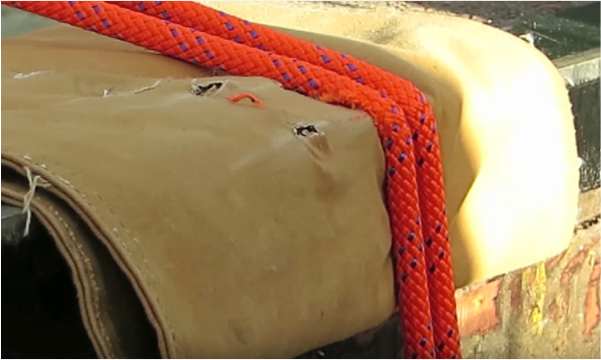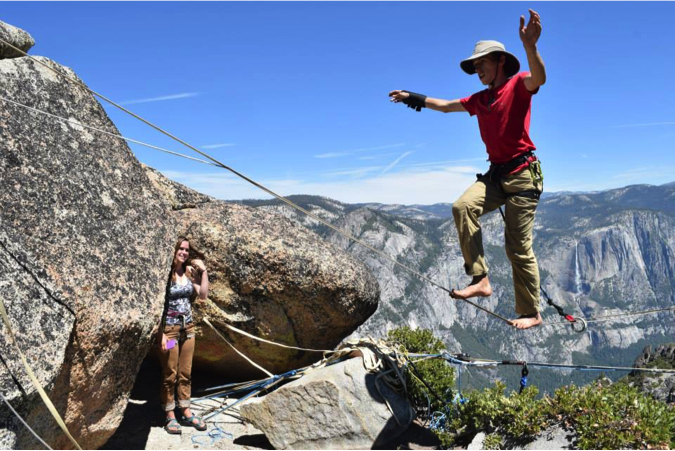You have no items in your shopping cart.
0
You have no items in your shopping cart.
Let’s take a trip to a highline rigged in a beautiful location. Imagine yourself sitting at the anchor, ready to walk this magnificent line. What do you do before getting on the line? Check the anchors, make sure everything is bomber. Check the weblock, making sure the webbing is loaded correctly. Check the backup to see that it is properly anchored as well. Check the knots on the leash rings. Check around the line to ensure there are no abrasion risks and that the line is padded adequately. Give the line a shake to check the tension. Look and see if the backup is the right tension.

Oh wait, the backup looks tight! There are no backup loops hanging between each tape. We know that having a tight backup makes lines more challenging to walk. It looks like we might have to loosen the backup line. But, does this change the safety of the line?
The current trend with highlines is to rig with a backup that has visible hanging loops between each tape, which is understood to make the line easier to walk.
Sometimes, this style of rigging can be amazing and add enjoyment to a particular line. However, in other cases, which we will discuss further, this style of rigging can be quite dangerous. I’ve begun to see a trend that the backup line is more used as a walking aid rather than an actual backup line. When the priority is to have a walkable highline, sometimes it’s easy to overlook certain safety risks.
I will be discussing 2 concerns that I have that present themselves with this style of rigging with supporting research from the Technical Rescue field.
The first concern that I would like to discuss is Abrasion. Abrasion at the lip of highlines is always a concern. However, when a highline is rigged with a loose backup, this concern is magnified.
There are two types of highline rigs that are especially worrisome to me: lines that are rigged in locations where abrasion is a possibility at or near the edge and highlines that are rigged such that the line hovers over an edge near the anchor where it is initially thought that abrasion is not a problem. Both of these types of rigs concern me with regards to potential for backup line (and mainline) abrasion.


Recently, I attended a talk by J.R. McCullar at the International Technical Rescue Symposium comparing two tensioned rope systems to tight mainline, loose backup line systems in a technical rescue situation. They performed a series of tests where they dropped a large mass onto these two types of systems running over a sharp edge. They performed this test with various sizes of rope and various amounts of slack in the mainline, loose backup system. The results of this test suggest that when a mass falls on to a tight rope/webbing with a loose backup rope/webbing from height and the ropes/webbings come in contact with a sharp object, these ropes/webbings are subject to failure more so than if that same mass were to fall on a set of tensioned ropes/webbings.
Here are a few small clips from this series of testing:
View more information about this test here: http://boxalarmtraining.com/itrs2015/
These test results got me thinking about the two highline situations I mentioned before. If and when one of these types of highlines experiences a mainline failure and a loose backup line hits a rock on the way down or slides across the rock at the edge, it’s going to look a lot like the ropes in these tests. Even if the backup line is well protected with many wraps of tree pro or commercial abrasion protectors, it will have a huge possibility of experiencing destructive levels of abrasion, as we can clearly see from these test results.
Also, if you read into these tests further and look at some of the results they found, you can see that during a mainline failure event, a loose backup can cause a very large fall distance. So, in the event we have a mainline failure on a line with a loose backup hovering over a potential abrasion point, it will become more likely that the backup line actually meets that abrasion point, creating a huge problem.
This leads me into my next concern: Ground Fall. This is actually the bigger concern I have for this new style of rigging, especially as the lines get longer.
The gold standard in todays highline world is to use a static rope as your backup line, rigged with visible loops hanging between the tapes, even when you are standing in the middle of the line: the point at which the mainline is the longest. This often means having an additional several meters of length in the backup line compared to the mainline. If a mainline failure were to happen, having this type of backup could result in a massive fall, especially when using a nylon or polyester static rope. In places were there isn’t much height, there is very high risk of ground fall, even if it does not appear to be so initially.

Again, at the International Technical Rescue Symposium last year, I attended a talk by Larry Walters looking at fall arrest distance when using an MPD in comparison to a Tandem Prusik Belay.
The gist of the test was they had a 275 kg mass hanging from a 21m long rope that went up to a pulley and then down to an MPD or Tandem Prusiks attached to a tree. They varied the amount of slack in the rope before dropping the mass onto the system, measuring how far it took for the mass to stop.
These results aren’t entirely relevant to our field as they were primarily looking at slippage between the two types of belay systems, but the data indicates that a backup line fall might be further than we expect.
Here are some of the results they found:
You can read more about this test here: http://itrsonline.org/the-modern-day-belay/
It’s quite clear from these results that having more slack in the system can result in higher than expected fall distances.
To close, i’d like to ask, is it worth it? In those cases where a loose backup increases the risk of a line, is it worth it to make the line easier to walk at the expense of your safety? Would you rather put yourself in potential danger than get on a harder than normal highline?
Backup lines are not meant to primarily serve as a walking aid. If a loose backup may increase the risk of a line, perhaps it’s worth it to leave the backup tighter than you would normally. A difficult and safe line is a lot better than an easy line that could cause you great injury or even death if something went wrong.
With an impressively good safety record, safety is paramount in slackline rigging. Let’s keep it that way and think about the risks involved with certain rigging decisions. Sometimes it’s worth it to have a more challenging line to walk if it means you will be safe, even in a mainline failure event.
For more information checkout the following links:
| Product | Price | Quantity | Options | |||||
|---|---|---|---|---|---|---|---|---|
| Features |
| Availability: |
| Price |
| Options |
| Actions |

← Older Post Newer Post →
0 comments